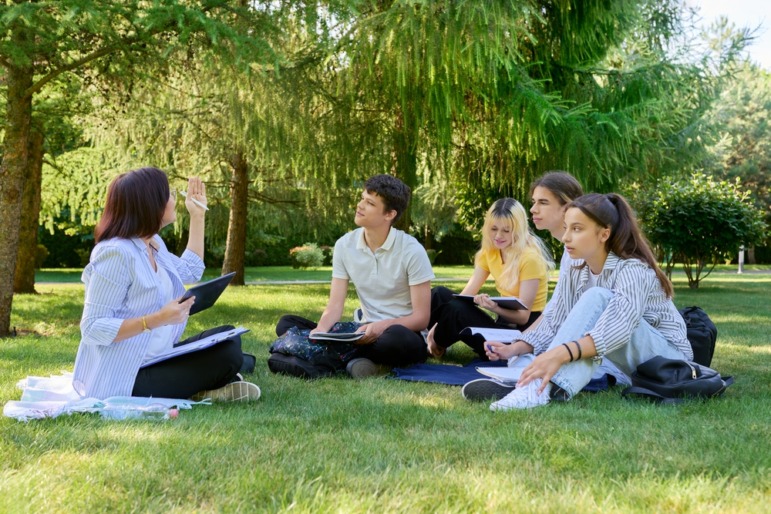When it comes to summer learning, the benefits are well documented. Students who consistently attend well-planned, high-quality programs achieve higher scores on math and language arts testing. They also earn higher ratings from teachers on their social and emotional skills, research shows. Unfortunately, research also shows that students from low-income and minority backgrounds are less likely to attend – and benefit from – summer learning programs than their affluent and white peers.
Summer learning can play a crucial role in helping these students – and all kids – recover learning lost during the pandemic. The federal government has also acknowledged the importance of summer learning through its Elementary and Secondary School Emergency Relief Fund, or ESSER. The fund infused states with nearly US$190.5 billion, with 20% allocated to academic recovery, including summer programs.
So how can school districts capitalize on the crucial summer months and make learning more equitable?
In partnership with the Wallace Foundation and the District Summer Learning Network implemented by the nonprofit development organization FHI 360, our team at the Center for Policy, Research, and Evaluation at New York University is studying how districts implement high-quality summer programs with an eye toward equity.
We analyzed 2022 summer planning documents from 26 districts and identified four strategies they’re using to make the programs more equitable:
- Strategically target students
- Reduce barriers to access
- Design courses for specific student populations
- Engage families in planning and programming
1. Strategically target students
Of the summer learning plans we analyzed, we found that half prioritized students who need academic or behavioral support. Additionally, 42% mentioned English-language learners, and 35% mentioned students with disabilities.
Other distinct groups included low-income students, migrants, racial and ethnic minorities and gifted and talented students. Among districts that prioritized special groups, almost all of them included more than one group in their strategic outreach.
Which students get served in summer learning programs, and how they are served, has implications for equity. For instance, research has found that middle-income students often benefit more from summer learning programs than lower-income students.
This could be because high-quality programs tend to serve higher-income students, which raises concerns that summer learning programs may actually increase the summer gap if they are not targeted. High-quality programs that target lower-income students and other minority students can move the needle toward equity.
2. Reduce barriers to access

Lopolo/Depositphotos
Accommodations allow access to summer programs to more students.
For students to access programs outside of the regular school day in an equitable way, simple accommodations, such as transportation, are key.
Several district summer learning plans we analyzed went above and beyond academics. They provided not just transportation but also free and nutritious meals, outreach material in different languages and extended day care services to support working families.
3. Design courses for specific student populations
Students learn best when they feel a sense of safety and belonging. By affirming and nurturing the unique identities of students, districts can make summer programming more equitable and accelerate learning. Research shows, for instance, that summer supports for English-language learners are key for their overall academic development.
Some districts tailored their programming to the individual interests and cultural needs of their students. For example, three districts – in both urban and rural communities – provided language classes for English-language learners, including adults.

Valerii Honcharuk/Depositphotos
Young adult learners in a summer school class.
Another district designed an arts program for students to explore and celebrate their culture. The program featured programming around ethnic and racial identities.
Despite a shortage of teacher applicants across the country, some districts also made efforts to hire teachers who are not only effective and well credentialed but also reflect the demographics of the student body they serve.
4. Engage families in planning and programming
Some districts held regular family education sessions to provide updates about student needs and progress. Some also engaged families by offering information sessions on topics such as immigration and health.
Programs that include the whole family or community are particularly helpful for racially, ethnically and linguistically diverse populations and families in rural areas, where young people have limited access to adults other than their caregivers.
When parents are included in the planning process, programs can be designed to better fit their schedules. This might mean districts offer full-day, six-week camps to support children throughout the summer while their parents work. This type of arrangement makes it more likely that kids will be able to attend summer programs – and stave off summer learning loss.
These four approaches help make summer learning programs more culturally responsive, accessible and inclusive. Over the next two years, our research will dive deeper into how districts strengthen equity-based practices and strategies to sustain them long term.![]()
***
Rhea Almeida, Research Project Manager, NYU Metro Center for Research on Equity and the Transformation of Schools, New York University, is a policy researcher and youth development expert. She believes in bottom-up approaches to social justice, equity-centered policy design, coalition-building, and strategic advocacy. Formerly a news journalist and freelance writer, she covered elections, women’s rights, education, the climate crisis, and labor policy, while working across mediums of TV, digital, and podcasts.
This article is republished from The Conversation under a Creative Commons license.


























